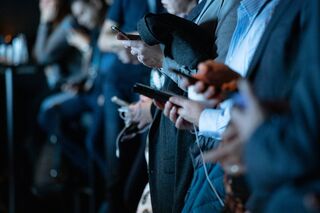Cross-Cultural Psychology
The Psychology of Social Cohesion in The Digital World
What happens to American culture when we all have different online experiences?
Posted November 12, 2021 Reviewed by Tyler Woods
Key points
- While online platforms have large networks, no two people have the same online experience.
- One exception to this trend in the realm of digital content is Netflix, who have a unique ability to control the cultural zeitgeist.
- The atomization of online life also mirrors a much more general trend in the decline of shared consumer experiences.
Very few modern brands appeal across class lines. This has lead to a decline in shared consumer experiences and consumer serendipity. However, the largest, most well-subscribed brands are, unsurprisingly, in the digital space. While the reach for these brands is broad, the experience is anything but unified. Spotify has quickly risen to be a dominant force in music streaming. One needs only to see the yearly Spotify reports to see how different consumers' listening habits are. Their 28 million users may all be familiar with the same logo and interface, but that's as deep as the shared experience goes.
Another case of disparate consumer experience is Amazon. At the start of 2020, Amazon Prime had a staggering 112 million U.S. users. However, the consumer experience is as varied as Amazon's product array. Some people go onto Amazon Prime to order paper towels, others to buy American flags, others still to buy Soylent meal replacements.

Social media platforms carry a similar paradox. Facebook has a whopping 225 million users in the U.S. alone, roughly 75 percent of the adult population. And yet, each social feed is curated to the individual's specific social network, interests, data history, etc.
This phenomenon is also reflected in the advertisements one sees in their feeds. As Ari Lightman, Professor of Digital Media and Marketing at Carnegie Mellon University described it, "The science of marketing has exploded. Now we have multi-modal data that can be interpreted through machine learning algorithms in order to understand individual consumers. Specialized psychographic approaches, as well as niche, micro-influencer tactics are increasingly common".
All in all, both for social content and sponsored advertisements, one's experiences on social media is as unique and individualized as one's fingerprints.
How Netflix Is Shaping Culture, Community, and the Zeitgeist
The one exception and saving grace to social cohesion might be Netflix. The dominant player in the red hot streaming competition, Netflix boasts an industry-leading user base of over 80 million subscribers as of 2021. While not free, like Facebook, its relatively inexpensive monthly fee makes it accessible across socioeconomic lines.
Most of the time, like any digital platform, the consumer experience is highly curated. Netflix's personalized algorithms learn about viewer preferences and then naturally corral viewers towards movies and shows they're most likely to enjoy. Some people go to Netflix for the baking shows, some go for Narcos. In a way, they're very similar to the other large platforms discussed above. There's something different for everybody.

And then, all of a sudden, in the pandemic's quarantine, there was a single show for everyone. Enter Tiger King. Who knew that a melodramatic gun-toting drug-addled Oklahoman would captivate the nation? Seen by over 64 million people in its first few months, the controversial documentary miniseries was nothing short of a cultural phenomenon. People had Tiger King-themed weddings, Tiger King-themed funerals, and everything in between.
Once the show reached a critical mass, the social pressure not to be the last to watch it only intensified. When your friends are referencing a show, talk show hosts can't stop talking about it, and politicians are tweeting about it, how can you resist seeing what the fuss is about? It's no exaggeration to say that Tiger King was more than a show; it was a defining feature of the cultural zeitgeist. Other networks have hit shows as well. Game of Thrones had its moment and its fair share of fandom. But the sheer reach of Netflix makes its hits more of a widespread American phenomenon. When a hit show sweeps has 80 million viewers, that's a shared cultural experience.
American Middle Class and the Decline of Retail Experience and Shopping Malls
Netflix aside, there’s been a sharp decline in the opportunity for shared experiences. Historically, many businesses very literally provide an opportunity for social cohesion and community. Think about a neighborhood barbershop, cafe, or farmer's market. These local businesses are what sociologist Ray Oldenberg called the all-important "third places"—a place outside the home, and outside of work, where people of all backgrounds could intermingle.
As author Noreena Hertz wrote in her 2020 book, The Lonely Century, these types of places "...play critical roles in maintaining our social fabric because they are places where we can practice community and democracy in their most inclusive form—places where, as in a book club, people may bring wildly different worldviews and lived experiences that must be reconciled, calibrated, understood, and discussed in order for the space to thrive."
The COVID-19 pandemic upended many community-based businesses, but their degradation predates the pandemic by several years. At a macro level, there's been a coming apart of our social fabric, aided by a lack of shared consumer experiences. At the same time, social media has posited influencers as The American Dream. However, One key phenomenon serves as a microcosm for this consumer-based social erosion: The slow decay of the American mall.

The American mall came to prominence in the 1960s and was pioneered by Austrian architect Victor Gruen. As described in the consumer psychology book, Blindsight, he designed the mall not as a commercial hub, but as an essential node in American suburban life. He reasoned that if he created an enjoyable space, people would want to spend their time there, and while there, they would naturally spend money. In Gruen's mind, profitability was just a nice side effect of good retail design.
He was right. In 1975, malls and shopping centers accounted for 33 percent of all retail sales in America. At their height in the 1980s, 1,000 new malls were built in America every year. But, as the middle class declined and e-commerce became more commonplace, the American mall began to decline as well. Today, only 1,000 are still in existence, and it's estimated that a third of these will shutter their doors by 2022.
The decline of the American mall is emblematic. As Nelson Schwartz wrote in The Velvet Rope Economy, "These stores, like the malls they occupied, were more than a place to shop. They were places where middle-class people, especially women, could gather and find a like-minded community of fellow shoppers".
The end result is more than just isolation among individuals. It's human nature to seek connection, which is enabled by a healthy glue within society at large. "When the middle class starts to crumble, people increasingly see themselves as different from others," Schwartz cites Law Professor Ganesh Sitaraman. "They sort themselves by wealth, by education level, and the result is that there's an increasing fracturing of society, a loss of the solidarity that comes with having a large middle class. And that can be very destructive to a republic."
The pandemic has made intermingling difficult, unwise, or impossible. But it's not where social isolation began. The pandemic accelerated a longstanding trend that goes back much further.
What are the consequences of a frayed social fabric? Next, we turn to why this matters, and the importance of social cohesion.
This post also appeared on the human nature blog, Neuroscience of.
References
Hertz, N. (2021) The Lonely Century (p. 208). Crown. Kindle Edition.
Thomas, L. (June, 2019) A third of America’s malls will disappear by next year, says ex-department store exec, MSNBC
Schwartz, Nelson D (2019). The Velvet Rope Economy (p. 260). Knopf Doubleday Publishing Group. Kindle Edition.
Pew Research Staff (Dec, 2020). America Middle Class is Losing Ground, Pew Research https://www.pewresearch.org/social-trends/2015/12/09/the-american-middl…




